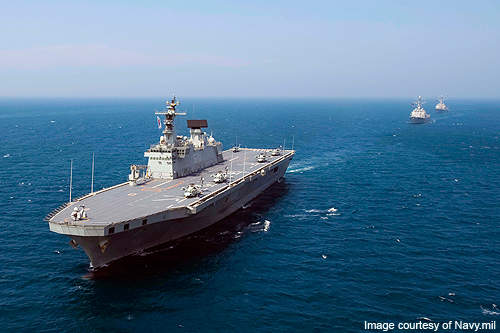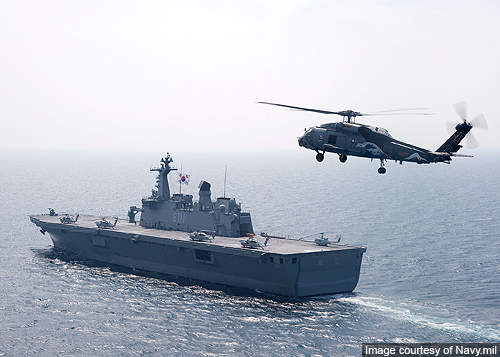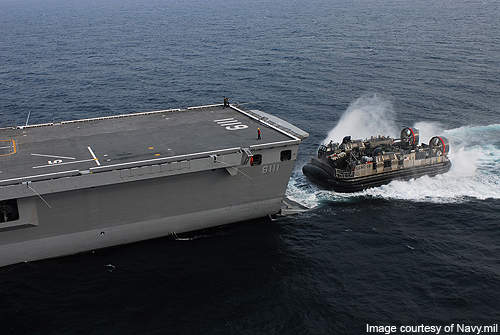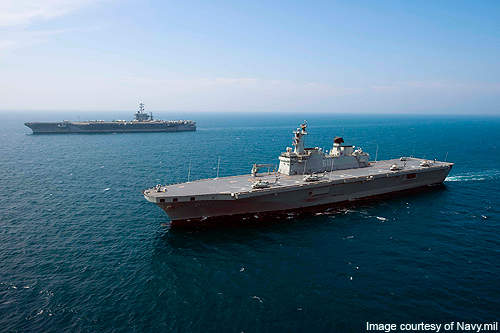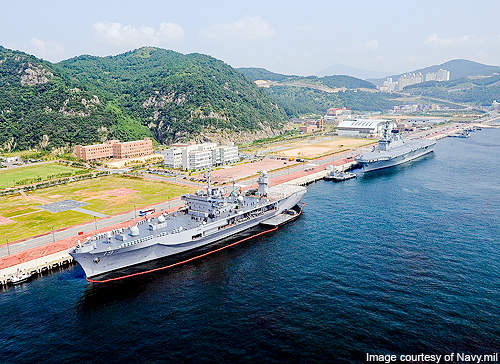ROKS Dokdo (LPH 6111) is the Landing Platform Helicopter (LPH) of the Republic of Korea Navy (ROKN). The LPH was built by Hanjin Heavy Industries and Construction in Busan. The ship was named after the Dokdo islets in the East Sea.
The lead ship in its class, ROKS Dokdo (LPH 6111), was launched in July 2005 and commissioned into the ROKN in July 2007. The ROKN also planned to deploy two similar ships intended for strategic mobile units. The second and third units will be named Marado (LPH 6112) and Baengnyeong (LPH 6113).
Dokdo LPH acts as a command and control platform for the maritime mobile fleet and supports three-dimensional landing operations as well as maritime air operations. It can also be deployed in a range of operations including in support of national overseas policy, peacekeeping operations, disaster recovery, counter-terrorism operations and national prestige enhancement.
Dokdo is the largest vessel in the South Korean Navy. It has almost similar specifications compared to the Spanish Navy’s aircraft carrier Príncipe de Asturias and the Thai Navy’s Chakri Naruebet light aircraft carrier.
Design and features
The hull is divided into four decks to accommodate helicopters, assault amphibious vehicles (AAV), landing craft air cushion (LCAC), tanks and trucks. Accommodation facilities, command posts and crew life support systems are located on deck 2.
Developed based on the concept of over-the-horizon assaults, Dokdo can conduct amphibious landing operations with high-speed LCAC and helicopters from beyond the horizon.
The ship’s combat data system manages and controls onboard weapons and allows the ship to command support vessels and aircraft in the strategic mobile operation fleet.
The ship has an overall length of 199m, a width of 31m and a draught of 7m. The standard displacement of the vessel is 14,000t and full load displacement is 18,000t. The LPH can carry over 700 marines, 10 trucks, six tanks, six AAVs, three field artillery pieces, 10 helicopters and two LCACs. Dokdo can complement more than 330 crew members.
Aircraft capabilities
The flight deck can accommodate five UH-60 Black Hawk helicopters at a time. The aircraft hangar facility is provided for UH-60 helicopter and the AH-1 attack helicopter. The aeroplane shed on the lower deck is a multi-layer structure equipped with elevators.
The flight deck is covered with Urethane to withstand the heat created by the aircraft during operations.
The ship can operate short-range and VTOL (vertical take-off and landing) aircraft such as the Harrier or F-35B, when equipped with a ski jump board module.
Weapon systems
The LPH is armed with RIM-116 RAM (rolling airframe missile) system. RAM is an infrared homing surface-to-air missile used against anti-ship cruise missiles.
The missile can travel at a maximum speed of Mach 2 while carrying a blast fragmentation warhead for a range of 9km. The ship is also fitted with two goalkeeper close-in weapon systems (CIWS) supplied by Thales Nederland. The system provides close-point defence against incoming missiles and ballistic shells. The seven barrelled CIWS can fire 4,200 rounds a minute for a maximum range of 2,000m.
Radar technology
The ship’s long range volume search radar is the Thales SMART-L. The radar can detect and track targets within the range of 400km. The ship is also equipped with MW08 surface search radar and AN/SPS-95K navigation radar.
Propulsion system
Dokdo’s propulsion system is based on combined diesel and diesel (CODAD) plant. The propulsion system integrates four S.E.M.T. Pielstick 16 PC2.5 STC diesel engines. These engines were licence built in Korea by Doosan Heavy Industries and Construction.
Each engine, rated at 7,650kW, is equipped with sequential turbo charging (STC) system. The CAE Integrated Platform Management System (IPMS) monitors and controls the hull, propulsion, electrical distribution, steering and battle damage control systems. The propulsion system provides a maximum speed of 23kt and cruising range of 10,000nm at 18kt speed.
The Global Naval Surface Combatants and Warfare Systems Market 2011-2021
This project forms part of our recent analysis and forecasts of the global naval surface combatants and warfare systems market available from our business information platform Strategic Defence Intelligence. For more information click here or contact us: EMEA: +44 20 7936 6783; Americas: +1 415 439 4914; Asia Pacific: +61 2 9947 9709 or via email.

